Moniek Bloks's Blog, page 46
June 15, 2024
Book News Week 25
Book News week 25 – 17 June – 23 June 2024
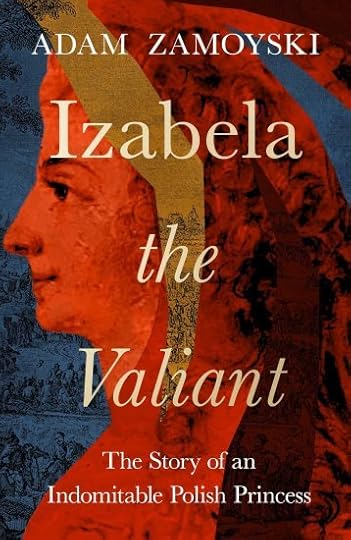
Izabela the Valiant: The Story of an Indomitable Polish Princess
Hardcover/Kindle – 20 June 2024 (US & UK)
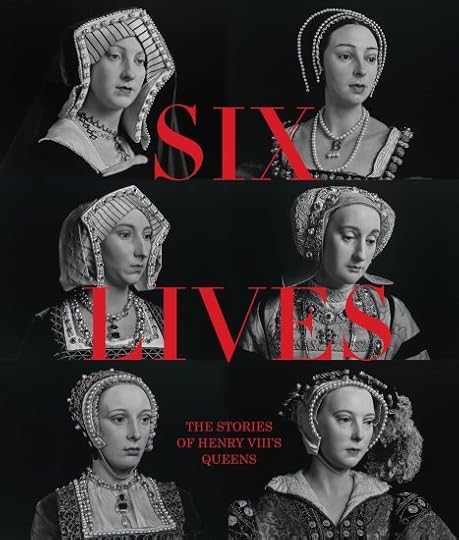
Six Lives: The Stories of Henry VIII’s Queens
Hardcover – 20 June 2024 (UK)
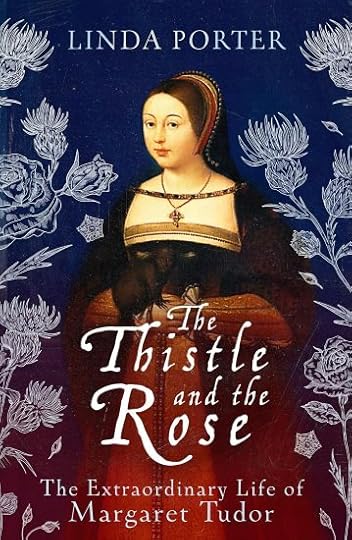
The Thistle and The Rose
Hardcover – 20 June 2024 (UK & US)
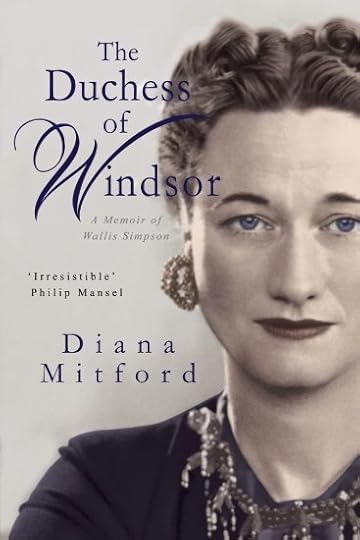
The Duchess of Windsor: A Memoir of Wallis Simpson
Paperback – Large Print, 20 June 2024 (UK)
The post Book News Week 25 appeared first on History of Royal Women.
June 14, 2024
Empress Fu Shou – The deposed Empress who tried to save the Han Dynasty
Empress Fu Shou was the first Empress of Emperor Xian, the last Emperor of the Han Dynasty. Empress Fu Shou has long been regarded as a tragic heroine.[1] She tried to save the falling Han Dynasty, but she couldn’t.[2] Instead, it not only cost her life but also the execution of almost her entire family. Yet, the greatest tragedy was that her husband could not save her because he was a puppet Emperor.
The birth date of Empress Fu Shou remains unknown. She was born in Dongwu in Langye (modern-day Zhucheng District in Shandong Province).[3] Her father was Fu Wan, who was the Marquis of Buqi. Her mother was Liu Ying, who was the Princess of Yang’an and the daughter of Emperor Huan of Western Han Dynasty.[4] In 189 C.E., General Dong Zhuo overthrew Emperor Shao. He placed the eight-year-old Liu Xie on the throne as Emperor Xian. A year later, in 190 C.E., Fu Shou entered the palace to become a concubine to Emperor Xian. She was given the rank of Worthy Lady. On 20 May 195 C.E., Fu Shou was invested as Empress of China.
Shortly after Empress Fu Shou’s investiture, Dong Zhuo’s (who died in 192 C.E.) remaining army rebelled against the royal family. This forced Emperor Xian to flee across the Yellow River at night.[5] Empress Fu Shou led Emperor Xian’s concubines and other palace women out of the capital on foot.[6] She took several bolts of silk with her. Throughout her journey, Dong Cheng (Emperor Xian’s maternal uncle) tried to take the bolts of silk away from her.[7] Many attendants also tried to take the silk, which caused a melee that killed several attendants, and blood splattered the Empress’s clothes.[8] However, Empress Fu Shou stubbornly clung to her bolts of silk.[9]
When the party finally reached Anyi (northwest modern-day Xia District in Shanxi Province), they were exhausted and hungry.[10] Once they arrived, they met Cao Cao (who would be posthumously known as Emperor Wu of Wei). Cao Cao was in charge of the local forces that were fighting for the royal family. Cao Cao escorted Emperor Xian and Empress Fu Shou and her party to Xuchang. It was said that Cao Cao led them to Xuchang not just for protection but to observe them.[11] As a reward for rescuing them, Emperor Xian made Cao Cao the Grand Minister of Works and Chariot and Horse General. In 196 C.E., the royal family returned to the capital. However, they found the city to be mostly destroyed.[12] They moved the capital from Luoyang to Xuchang.[13]
Cao Cao began to be the most powerful man in court.[14] By 196 C.E., Emperor Xian was completely under his control and was a puppet Emperor.[15] Cao Cao also killed anyone who opposed him.[16] In 200 C.E., Cao Cao killed Dong Cheng. He even killed his daughter, Worthy Lady Dong, who was pregnant with Emperor Xian’s child.[17] These executions caused Empress Fu Shou to be afraid of him.[18]
In late 214 C.E., Empress Fu Shou wrote a letter to her father asking him to kill Cao Cao.[19] However, her father was greatly afraid of Cao Cao and dared not make an assassination attempt on him.[20] When Cao Cao discovered the plot, he was angry at Empress Fu Shou and decided to seek revenge against her.[21] He forced Emperor Xian to depose her.[22] He also forced him to write an edict stating that for twenty-four years as Empress, she “no longer had the virtue to teach the people.”[23] It also stated that “Empress Fu was a jealous and spiteful person and had planned murder, and therefore was not qualified to remain Empress.”[24] The edict finished with: “It is a great pity, but she has brought this upon herself. We are not handing her over to the court trial because we are treating her leniently.”[25]
Empress Fu Shou was forced to give up her imperial seal and ribbon.[26] Soldiers arrested the deposed Empress Fu Shou.[27] As she was led out of her palace barefoot with unkempt hair, she passed by Emperor Xian.[28] She wept, and her last words to him were: “Can’t you save my life?”[29] Emperor Xian replied, “I don’t know when my turn will come.”[30]
The deposed Empress Fu Shou was sent to the women’s prison.[31] She died there on 8 January 215 C.E. One historical record claimed that Cao Cao had the deposed Empress Fu Shou assassinated.[32] Her two sons were both poisoned.[33] Over a hundred of her family members were executed.[34] Her mother and nineteen of her remaining family members were exiled to the Zhu Commandery (modern-day Zhuzhou in Hebei Province).[35]
Empress Fu Shou is considered a heroine who tried to save her dynasty.[36] However, her enemy was too powerful for her to defeat. Her bold actions in fighting against General Cao Cao would have drastic consequences for her.[37] She would lose her throne, her husband, her life, her sons, and almost her entire family. Yet, the saddest part was that her husband could not even save her because he had no power. The Han Dynasty did not last long after Empress Fu Shou’s death. It fell five years later, in 220 C.E., and the Three Kingdoms War started. These events were dramatized in the infamous classic historical fiction novel, Romance of the Three Kingdoms.
Sources:
McMahon, K. (2013). Women Shall Not Rule: Imperial Wives and Concubines in China from Han to Liao. NY: Rowman and Littlefield.
Yang H. (2015). “Fu Shou, Empress of Emperor Xian”. Biographical Dictionary of Chinese Women: Antiquity Through Sui, 1600 B.C.E. – 618 C.E. (L. X. H. Lee, Ed.; A. D. Stefanowska, Ed.; S. Wiles, Ed.). NY: Routledge. pp. 142-143.
[1] Yang, 2015
[2] Yang, 2015
[3] Yang, 2015
[4] Yang, 2015
[5] Yang, 2015
[6] Yang, 2015
[7] Yang, 2015
[8] Yang, 2015
[9] Yang, 2015
[10] Yang, 2015
[11] Yang, 2015
[12] Yang, 2015
[13] Yang, 2015
[14] Yang, 2015
[15] McMahon, 2013
[16] Yang, 2015
[17] Yang, 2015
[18] Yang, 2015
[19] Yang, 2015
[20] Yang, 2015
[21] Yang, 2015
[22] Yang, 2015
[23] Yang, 2015, p. 143
[24] Yang, 2015, p. 143
[25] Yang, 2015, p. 143
[26] Yang, 2015
[27] Yang, 2015
[28] Yang, 2015
[29] Yang, 2015, p. 143
[30] Yang, 2015, p. 143
[31] McMahon, 2013
[32] Yang, 2015
[33] McMahon, 2015
[34] Yang, 2015
[35] Yang, 2015
[36] Yang, 2015
[37] Yang, 2015
The post Empress Fu Shou – The deposed Empress who tried to save the Han Dynasty appeared first on History of Royal Women.
June 13, 2024
Queen Mary’s Lover’s Knot Brooch
Queen Mary’s Lover’s Knot Brooch is “in the form of a knotted, brilliant-set bow, the tail of each ribbon made with two articulated joints.”1
Embed from Getty ImagesQueen Mary bought the brooch from Garrard in 1932, and it became one of six bow brooches she owed. It was bequeathed to Queen Elizabeth II in 1953, who wore it regularly.
The post Queen Mary’s Lover’s Knot Brooch appeared first on History of Royal Women.
June 12, 2024
Book Review: Informally Royal: Studio Lisa and the Royal Family 1936-1966 by Rodney Laredo
*review copy*
Informally Royal: Studio Lisa and the Royal Family 1936-1966 is about the photo studio “Studio Lisa”, run by Lisa and Jimmy Sheridan, who ended up taking many photographs of the royal family.
They were hired by the then Duke and Duchess of York to take photos of their family. They would go on to photograph the family a total of 13 times.
The book focuses on the founding and development of Studio Lisa, and it’s quite an engaging story. The relationship with the future King George VI and Queen Elizabeth is quite endearing, especially their earlier interactions. The collection of photos really does make this book really special.
If I had to say one negative thing, it would be that sometimes it feels like the photos aren’t where they’re supposed to be. As in, the text mentions a particular image, but that is not the one on the other page. However, overall, it’s a lovely book and a great addition to any collection.
Informally Royal: Studio Lisa and the Royal Family 1936-1966 by Rodney Laredo is available now in the UK and the US.
The post Book Review: Informally Royal: Studio Lisa and the Royal Family 1936-1966 by Rodney Laredo appeared first on History of Royal Women.
June 11, 2024
Gabrielle d’Estrées- The almost Queen of France (Part two)
Since meeting King Henry IV of France in the early 1590s, Gabrielle d’Estrées had risen through the ranks at court, becoming the King’s official mistress, being named a Duchess, and even earning a place on the King’s council. She was Henry’s romantic partner but also played a very important role in the governance of France as she was involved in many key decisions, policymaking, and negotiations. Gabrielle was a key player in convincing the King to convert to Catholicism to appease his people and in orchestrating peace with the Catholic League.
As time went on, Gabrielle continued to work tirelessly, and with the Catholics now under the King’s control, it was time to look towards the protestants, who were still in uproar due to their King converting to Catholicism and their lack of rights within the kingdom. Over the following years, Henry and Gabrielle entered negotiations, convincing Catholic nobles to agree to an act of religious toleration. The Edict of Nantes was signed in 1598 and assured civil equality and extended rights to France’s Huguenot population, this extremely important treaty brought an end to the religious wars.1
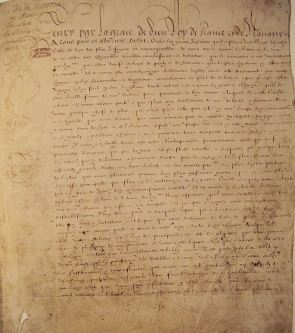 The Edict of Nantes (public domain)
The Edict of Nantes (public domain)Another role of a royal mistress was to bear children for the King. These children would often be given prominent roles at court, and beneficial marriages would be arranged for them to allow them to mix their illegitimate blood with that of the great houses of Europe. As well as their son César, Gabrielle gave birth to a daughter, Catherine-Henriette de Bourbon, in 1596 and another son, Alexandre de Bourbon, in 1598.2 The King and his wife, the Queen, still had no children, and the King began to put pressure on members of his council to have his marriage annulled with the hope he could marry Gabrielle. As many courtiers thought this was a terrible idea, the councillors dragged this matter out for years.3 Queen Margaret herself opposed the annulment, and she said: “It is repugnant to me to put in my place a woman of such low extraction and of so impure a life as the one about whom rumour speaks.” 4 The Queen may have been separated from the King, but she did not want him to marry Gabrielle.
In the later years of their relationship, Gabrielle acted as if she were Queen of France and was treated as such by many. She had a large household with over two hundred serving staff, and in 1598, she even moved into the Queen’s apartments.5 With Gabrielle pregnant with their fourth child, Henry took matters into his own hands and wrote to the pope to push for the annulment of his marriage. Cardinals and officials were even sent to the Vatican to plead with the papacy.6 Pope Clement VIII agreed that the marriage between Henry and Margaret of Valois had been over for a long time but was very apprehensive about passing the annulment because it was sure to cause a succession crisis in France upon the death of the King. It was unlikely that the French people would be happy about Henry’s bastard children succeeding to the throne, even if they were made legitimate and their parents eventually married. It was a disaster waiting to happen. People began to complain about the costs of Gabrielle’s household and the clergy preached about her openly.
Despite the lack of annulment, Henry gave Gabrielle his coronation ring and promised they would soon be married. Plans were made for the wedding to take place around April 1599.7 Gabrielle was ecstatic after waiting for this moment for ten years and supposedly proclaimed that only God or the King’s death could put an end to her good luck. It seemed she had spoken too soon, as Gabrielle suddenly became unwell.
At five months pregnant, Gabrielle was in Paris preparing for her wedding. With just days to go, she suddenly went into early labour. There were many rumours that she was poisoned at a meal with friends, but the consensus is that the Duchess was suffering from either eclampsia or placenta previa. These conditions are dangerous even today, but in the 16th century, they were almost always a death sentence. After writhing in protracted agony, giving birth to a stillborn son, and losing her senses of sight and hearing, Gabrielle passed away before the King could reach her.8 It is said that Gabrielle’s once beautiful face was so distorted by the convulsions that it became blackened and twisted, causing onlookers to faint at the sight of her.
Rather than marrying his beloved, King Henry IV provided her with a funeral fit for a Queen at Saint-Germain L’Auxerrois. She may not have accended the throne, but she was buried at Maubuisson Abbey following an impressive procession that included the royals and nobles of France.9 In an unprecedented move, the King wore black to signify his grief, something a King of France had never done before. The King even kept a wax effigy of his mistress and visited it for years following her death.
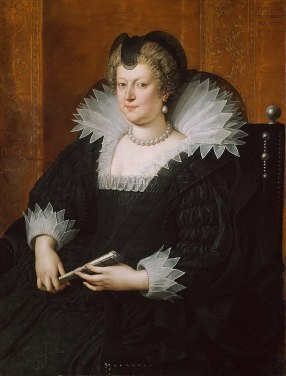 (public domain)
(public domain)Later, in 1599, Henry received the annulment he had been seeking for so long, releasing him from his marriage. With Gabrielle dead, Margaret no longer opposed the annulment. He wasted no time and was soon wed to Marie de’ Medici, the daughter of the Grand Duke of Tuscany, on 17 December 1600.10 This match made much more sense for France’s future, but people quickly compared the new Queen to Gabrielle, commenting that Marie was nowhere near as beautiful as Gabrielle.11
Marie de’ Medici went on to produce six children for the King, including an heir. However, these children were often overlooked by Henry IV as he preferred his children with Gabrielle. Gabrielle’s three children were raised in the royal nursery alongside the royal children and the children of another mistress, much to the Queen’s dismay.12
Gabrielle’s son, César de Vendôme, had a successful career at the court, becoming an important player in the reigns of Louis XIII and Louis XIV. Her daughter Catherine Henriette de Bourbon married Charles II, Duke of Elbeuf of the House of Guise. Their youngest child, Alexandre de Vendôme, was governor of Caen as well as ambassador to Rome, though he died in prison after taking part in an uprising.13
The post Gabrielle d’Estrées- The almost Queen of France (Part two) appeared first on History of Royal Women.
June 9, 2024
Gabrielle d’Estrées – One of the seven deadly sins (Part one)
By the mid-16th century, the role of the French Royal mistress was well-established at court. Though many disapproved, it came to be expected that the King would take a mistress, and she would hold power, not just over him but over certain factions, and she would elevate her own family to prestigious positions. After the departure of King Henry II’s mistress, Diane de Poitiers, however, there was no official royal mistress for nearly forty years. Following on from Henry II came the three short reigns of his ill-fated sons. Francis II did not take a mistress, and though Charles IX and Henry III did, they had no power as the reigns of the kings were not long enough to allow the power dynamics to evolve.1
In 1589, the Valois dynasty came to an abrupt end after 250 years upon the assassination of King Henry III. His successor was Henry IV, who was already King of Navarre and had a claim to the French throne through his father, Antoine of Bourbon. The new King was also married to Margaret of Valois, the daughter of Henry II and sister of the three previous kings which offered a little continuity in a difficult transition period.
During this time, France was in the midst of a religious war, and as the new King, Henry IV, was a protestant, he was not recognised by the Catholics. Henry IV was not even able to live in Paris during this time and was left without a central royal court. Henry struggled to find anyone he could trust during his early reign and had a non-existent relationship with his wife Margaret of Valois, who had been exiled for siding with the Catholic League against her husband. Seeking emotional support as well as lovers, Henry IV had many mistresses, including his official mistress Gabrielle d’Estrées.
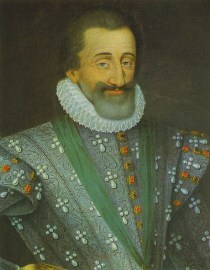 Henry IV (public domain)
Henry IV (public domain)Gabrielle d’Estrées was born in 1573 to Antoine d’Estrées, Marquis of Cœuvres and his wife Françoise Babou de La Bourdaisière. Her mother and sisters were known to have taken many lovers throughout their lives and were great beauties. Due to their many sexual liaisons, Françoise and her daughters were mockingly called the “seven capital sins.” 2 In early 1590, Gabrielle was seventeen and in a relationship with the grand equerry of France, Roger de Saint-Lary, Duke of Bellegarde. The Duke was close to the new King, King Henry IV, and it is believed that the womanising King became interested in Gabrielle when he heard about her incredible beauty in tales told by the Duke. We do not know how exactly the pair met, but the King fell head over heels in love with the teenager, who was not initially keen on a relationship with the older King. Gabrielle clearly stood out from the crowd as the King had taken dozens of lovers in the past, yet none were described quite like Gabrielle, who was said to have “exquisite colouring- pale blonde hair and large blue eyes.” 3
In the early years of their relationship, Henry IV was busy travelling around France, trying to subdue revolts by the Catholics who were opposed to a Protestant king. Things were difficult, and rather than being able to show off her dresses and jewels in the King’s palaces as a mistress usually would, Gabrielle was often found by the King’s side on the battlefield. Her quarters were cold, damp tents, and she would regularly cook for the King personally and wash his clothes by hand.4 These conditions and the fact Henry had few trusted advisors led the couple to become close very quickly. Gabrielle and her family rapidly rose to the top, with her relatives being given prominent positions.
During this period, King Henry IV was married to Queen Margaret of Valois, though the couple were living apart, and their marriage was a never-ending series of disasters from the get-go. Gabrielle herself was wed to Nicholas d’Amerval, Seigneur de Liancourt, though both unions were unhappy and it was widely known that Henry and Gabrielle were an item. Letters from everyone from Elizabeth I of England and the Pope mention Gabrielle, showing her importance early on. It was not long before Gabrielle became pregnant, and around this time, her marriage was conveniently annulled. During her pregnancy, Gabrielle stayed by her lover’s side; she provided her own funds for the King’s army, shouted orders on the battlefield, and sheltered from cannon fire. The King was so in awe of Gabrielle that he promised to marry her eventually and make her Queen of France.5
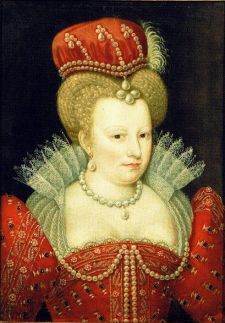 Margaret of Valois (public domain)
Margaret of Valois (public domain)After years of fighting, Gabrielle (and everyone else!) knew that if the King was to be accepted by the Catholic majority, he would have to convert to Catholicism, which he eventually agreed to, famously proclaiming, “Paris vaut bien une messe,” or Paris is well worth a mass.
Gabrielle’s influence on this decision cannot be understated, as she played a major role in the King’s conversion. Having recently been recognised as the King’s “Titular Mistress” and elevated to the position of Marquise de Monceaux, Gabrielle dedicated herself further to her diplomatic duties.6 Rather than flaunting her new title and wasting the nation’s taxes on jewels and clothing, Gabrielle dressed modestly and conducted herself in such a way that it was hard to dislike her. She used her skills and charms to write personally to the pope, explaining that it was through her hard work that the King had converted to Catholicism, and if she had not, France could have broken with Rome as England had under King Henry VIII.
Following his conversion, Henry was finally accepted as King of France, and after further negotiations, peace was reached with the Catholic League. Gabrielle also played a key role in these negotiations by arranging talks through the women who were close to the leaders of the Catholic League.
At long last, King Henry IV of France was crowned on 27 February 1594 in Chartres, followed by great celebrations throughout the kingdom.7 Until this point, Henry had been excommunicated by the Catholic Church, this was revoked by Pope Clement VIII, further securing his position.
Once the King had been crowned, he made his triumphal entrance into Paris, and it was Gabrielle, not the Queen, who was proudly at his side. She dazzled in the most beautiful dress covered in pearls and was carried in an open litter for all to see. Here, Henry was showing the importance of his Maîtresse-en-titre.8
In June of that year, Gabrielle gave birth to the couple’s first child together, a son who was boldly given the name César.9 Though born illegitimate, in time, the boy was legitimised by the King and later created the Duke of Vendôme. King Henry had no children with his wife Margaret of Valois and hoped that he could eventually marry Gabrielle and name César as his heir. The child was favoured greatly by the King and giving birth to the King’s son gave Gabrielle even more power at court.
By 1596, Gabrielle and the King’s relationship was going from strength to strength. The pair were openly affectionate in public, and the King declared his love to his mistress in long letters. Diplomats, ambassadors, and even foreign royalty acknowledged Gabrielle in correspondence, with gifts, and by meeting her in person for political discussion.
Everyone knew how essential Gabrielle was to the King’s reign, though she held no real position. In March 1596, Henry IV made the extraordinary decision to make Gabrielle part of his council. To avoid criticism from those who disliked Gabrielle, he also gave his sister Catherine a position on the council. Both women were awarded a small set of gold keys in recognition of their new roles.10 Gabrielle proudly wore these keys on a necklace, displaying her power openly.11
Part two coming soon.
The post Gabrielle d’Estrées – One of the seven deadly sins (Part one) appeared first on History of Royal Women.
June 8, 2024
Book News Week 24
Book news week 24: 10 June 2024 – 16 June 2024
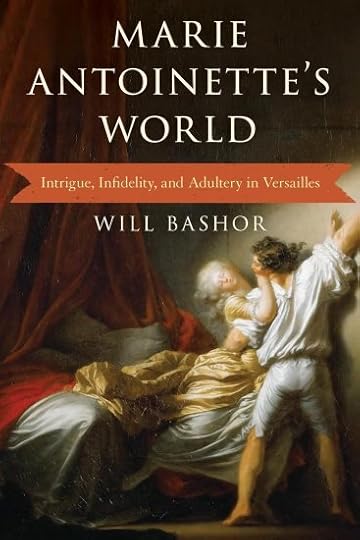
Marie Antoinette’s World: Intrigue, Infidelity, and Adultery in Versailles
Paperback – 16 June 2024 (UK)
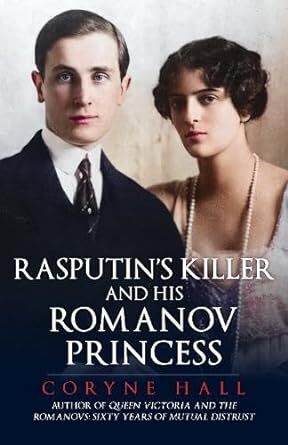
Rasputin’s Killer and his Romanov Princess
Paperback – 15 June 2024 (UK)
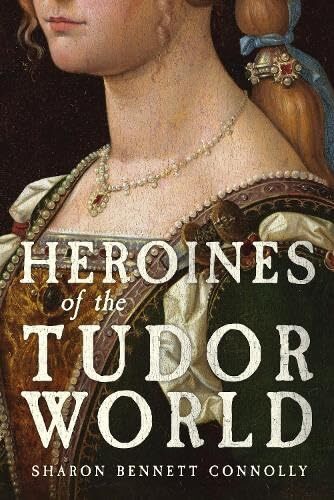
Heroines of the Tudor World
Hardcover – 15 June 2024 (UK)
The post Book News Week 24 appeared first on History of Royal Women.
June 7, 2024
Cassandane Shahbanu -The second Queen to King Cyrus the Great of the Persian Empire
Queen Cassandane Shahbanu was the second Persian Queen of the Achaemenid Dynasty. She was the second Queen to King Cyrus the Great of Persia. King Cyrus the Great married her in order to strengthen his alliance with the Achaemenids.[1] She was most likely the mother of Cambyses II, who would succeed his father as the next King of Persia.[2] Queen Cassandane Shahbanu was also known to wield much power and influence.[3] Even though she was very powerful, very little information is known about her.[4] Most of the known facts about her are still being heavily debated.[5]
Queen Cassandane Shahbanu was born sometime in the 5th century B.C.E. Her place of birth remains unrecorded. Her father was Pharnapses the Red, an Achaemenid.[6] Her mother is mostly unknown, except that she was not Egyptian.[7] It is unknown when she married King Cyrus the Great.[8] He married her in order to strengthen his alliance with the Achaemenids.[9] She was not his Queen.[10] His Queen was King Cyrus the Great’s aunt, Amytis Shahbanu.[11]
According to Herodotus, Cassandane was King Cyrus the Great’s favourite wife, and he loved her deeply.[12] Herodotus also claims that Cassadane was the mother of Prince Cambyses, Prince Bardiya, Princess Atossa, Princess Artystone, and Princess Roxana.[13] Still, it is unclear if Cassandane was King Cyrus the Great’s favourite wife.[14] While it is almost certain that Cambyses II was her son, it is still unclear if they were all her children.[15] Some of them may be from Queen Amytis Shahbanu or King Cyrus the Great’s other wives.[16] Herodotus also claims that Cassandane was very proud, especially in regard to Prince Cambyses.[17]
It is unknown when Queen Amytis Shahbanu passed away.[18] After her death, Cassandane became King Cyrus the Great’s second Queen of Persia.[19] He chose her as Queen because Prince Cambyses was his heir.[20] Queen Cassandane Shahbanu learned from Queen Amytis Shahbanu how to wield power and influence within the Persian court.[21] She was able to exercise her own authority.[22]
It is unknown when Queen Cassandane Shahbanu passed away.[23] Some scholars believe that King Cyrus the Great grieved deeply over her death.[24] He made Babylon mourn for her for six days.[25] However, other scholars believe that it was Queen Amytis Shahbanu whom King Cyrus the Great mourned.[26] It is also unclear whether it is Queen Cassandane Shahbanu or Queen Amytis Shahbanu who was buried in the tower of Zendan-e-Solayman in Pasargadae.[27]
Very little information regarding Queen Cassandane Shahbanu is known. Scholars are in dispute over whose children were hers.[28] They are also in dispute about whether she was the Queen that King Cyrus the Great mourned.[29] Scholars have also spent very little focus on how Queen Cassandane Shahbanu exercised her own power.[30] Instead, more attention and focus is paid to Queen Amytis Shahbanu and her role of queenship in Persian history.[31] With more scholarship, there may be more details about this little-known Queen. What is clear is that Cassandane Shahbanu was a powerful Queen, and her son would be the next King of the Achaemenid Empire.[32]
Sources:
Aizid, R. (2018). Sejarah Terlengkap Peradaban Dunia. Indonesia: Penerbit Noktah.
Dandamaev, M. A. (1992). “Cassandane.” Encyclopaedia Iranica. Vol. 5. Encyclopaedia Iranica Foundation. Retrieved on October 9 2023 fromhttps://www.iranicaonline.org/article....
Minsoo, S. (2017). Success strategies in emerging Iranian American women leaders. [Doctoral dissertation, Pepperdine University]. Pepperdine Digital Commons. https://digitalcommons.pepperdine.edu....
Rose, D. & Allen, R. (2018). Ancient Civilizations of the World. United Kingdom: EDTECH.
Waters, M. W. (2022). King of the World: The Life of Cyrus the Great. NY: Oxford University Press.
Zarghamee, R. (2015). Discovering Cyrus: The Persian Conqueror Astride the Ancient World. Washington D.C.: Mage Publishers Incorporated.
[1] Waters, 2022
[2] Zarghamee, 2015
[3] Minsoo, 2017
[4] Minsoo, 2017
[5] Waters, 2022
[6] Zarghamee, 2015; Waters, 2022
[7] Waters, 2022
[8] Waters, 2022
[9] Waters, 2022
[10] Aizid, 2018; Minsoo, 2017
[11] Aizid, 2018; Minsoo, 2017
[12] Waters, 2022
[13] Waters, 2022
[14] Waters, 2022
[15] Zarghamee, 2015; Waters, 2022
[16] Waters, 2022
[17] Waters, 2022
[18] Minsoo, 2017
[19] Minsoo, 2017
[20] Zarghamee, 2015
[21] Minsoo, 2017
[22] Minsoo, 2017
[23] Waters, 2022
[24] Dandamaev, 1992
[25] Dandamaev, 1992
[26] Aizid, 2018
[27] Dandamaev, 1992; Aizid, 2018
[28] Waters, 2022
[29] Dandamaev, 1992; Aizid, 2018
[30] Minsoo, 2017
[31] Minsoo, 2017
[32] Minsoo, 2017; Zarghamee, 2015
The post Cassandane Shahbanu -The second Queen to King Cyrus the Great of the Persian Empire appeared first on History of Royal Women.
June 6, 2024
Queen Mary’s Floret Earrings
Queen Mary’s Floret Earrings are “set with seven small brilliants surrounding a large brilliant, in openwork claw settings.”1
The brilliants in the centre of the floret earrings were originally a pair of solitaire earrings. They were given to Queen Mary for her wedding in 1893 by Sir William Mackinnon, Bt. They were then set in another pair of earrings known as the cluster earrings in 1922. In 1939, they were reset again in their current form.
Embed from Getty ImagesThey were inherited by Queen Elizabeth II in 1953.
The post Queen Mary’s Floret Earrings appeared first on History of Royal Women.
June 5, 2024
Isabella of England – A secluded Empress
Although she was an empress, Isabella of England spent much of her marriage in seclusion. Although she does not seem to have wielded any power herself, she is seen as an important figure in connections between England and the Holy Roman Empire.
Early Life
Isabella was born in 1214 to King John of England and Isabella of Angouleme. She was the fourth of their five children and the second of their three daughters. She was born during a time of high tension during her parents’ marriage. She never really got to know her father, for he died in 1216 when she was just two. Soon afterwards, her nine-year-old brother, Henry III, became the new King of England. Their mother returned to France and remarried in 1220, and Isabella continued to be raised at the English court. Soon afterwards, Isabella’s older sister, Joan, was betrothed to King Alexander II of Scotland. Since Joan was in France at the time, it was decided that if she were not to make it back to England by 29 September or two weeks after that, Alexander would marry Isabella instead. However, Joan made it back in time and was married to Alexander.
In 1225, a marriage was considered between Isabella and Henry, the oldest son of Frederick II, Holy Roman Emperor and King of Sicily. However, later that same year, Henry married Margaret of Austria instead. Later, a marriage to Louis IX, King of France, was also considered, but nothing came of this. In 1232, Isabella, still unmarried, had her own household with at least a dozen attendants.
Marriage
In 1234, Frederick II, Holy Roman Emperor, sent an embassy to England to propose a marriage to Isabella. Frederick had been twice widowed; his first marriage was to Constance of Aragon, and his second marriage was to Isabella II of Jerusalem. He had two sons, one by each wife. His older son, Henry, had once been a possible match for Isabella. Henry was three years older than Isabella. The possibility of Frederick marrying Isabella was suggested to him by Pope Gregory IX.
In February 1235, Henry III of England agreed to Isabella’s marriage to Frederick. Henry summoned Isabella from the Tower of London, where she lived, to Westminster. The ambassadors were impressed with her and gave her a betrothal ring, proclaiming her as Empress. Isabella and Frederick were betrothed in February 1235, and Isabella was given a dowry of 30,000 marks.
Isabella sailed from England in May 1235. The preparations for this wedding were among the most lavish of the time. Isabella was accompanied by a large retinue and brought a splendid trousseau with her. She landed in Antwerp after a four-day sea journey. Isabella then continued on to Cologne. On the way, a large escort provided by the Emperor protected her because there were rumours that Frederick’s enemies wanted to abduct her. Isabella arrived at Cologne on 22 or 24 May. When Isabella entered the city, everyone wished to see her face, so she removed her veil so everyone could get a glimpse of her.
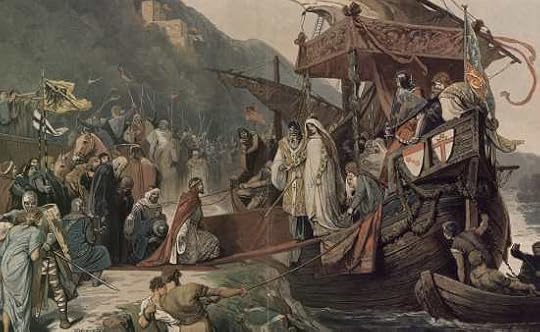 Frederick receives Isabella (public domain)
Frederick receives Isabella (public domain)Isabella spent six weeks in Cologne waiting for Frederick. Meanwhile, he was dealing with a rebellion led by his oldest son, Henry. After Henry was tried and arrested, Isabella entered Worms, where the wedding was to take place. Isabella and Frederick were married in July 1235. There are three different dates given for the wedding- July 15, 20, or 30. The nuptial festivities went on for four days in a row. After the celebrations ended, Frederick sent costly gifts to the English king and promised to help him against the French. Around this time, Isabella was crowned as Holy Roman Empress and Queen of Sicily.
Empress
Soon after the wedding, Frederick sent most of Isabella’s attendants back to England. Isabella spent the first year of her marriage in Germany and gave birth to her first child in late 1236 or early 1237. She was in Italy by August 1337. Throughout the marriage, Frederick and Henry maintained correspondence. In 1237, Isabella received a personal letter from Henry. The personal correspondence between Isabella and Henry seems to have been controlled, and it is possible Isabella expressed disappointment about her marriage to her brother.
In February 1238, Isabella gave birth to a boy named Henry. The exact number of children she had is debated; estimations range from three to five. Her first child is sometimes believed to be her daughter Margaret, who survived to adulthood but is sometimes identified as a daughter named Agnes, who died in infancy. Some also identify her first child as a son named Jordan, who died in infancy. However, all sources agree that Henry was the child Isabella gave birth to in 1238.
Isabella often remained separate from Frederick as he visited his vast domains. She spent most of her marriage in Italy, which was part of the Empire at the time. Isabella was not politically active. In fact, it seems like Frederick preferred to keep her away from any power or influence. In the summer of 1241, Isabella’s second brother, Richard, was returning home from crusade, and stopped in Sicily, hoping to see Frederick and Isabella. However, he was told they were in northern Italy, so he headed there. Richard met Frederick at Faenza. He requested to see Isabella, but Frederick seems to have turned down his request at first. At this time, Isabella was pregnant and was perhaps feeling unwell. Richard waited for a few days and made a formal request. This time he was able to visit her, and brother and sister were presented with a display of jugglers and dancers.
King Henry of England expressed disappointment that his sister did not participate in public ceremonies and was rarely seen wearing a crown. Sometimes, Frederick is said to have kept Isabella, as well as his second wife, imprisoned. While this does seem to be an exaggeration, it seems very likely that he kept them in seclusion and prevented them from being involved in public affairs. This was very different from Frederick’s relationship with his first wife, Constance, who even acted as regent of Sicily when he was away.
Isabella died in childbirth on 1 December 1241. She had just given birth to a daughter; some sources say it was Margaret who survived to adulthood; others say it was Agnes who died soon afterwards. Isabella’s last wish was that Frederick and Henry remain friends, which they did. Isabella was buried in Andria Cathedral alongside Frederick’s second wife. Isabella was deeply mourned by Henry, and he donated alms in memory of her. Frederick did not make another diplomatic marriage after Isabella’s death, but at one point, he married his longtime mistress, Bianca Lancia.1
The post Isabella of England – A secluded Empress appeared first on History of Royal Women.



